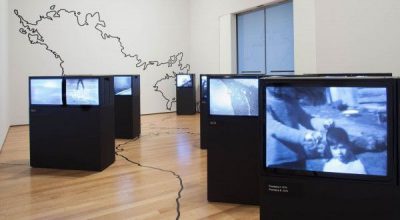
MAKE ART A FORM OF UNIVERSAL LITERACY. A LETTER FROM LUIS CAMNITZER
[Spanish]
Luis Camnitzer, Uruguayan artist and writer, was one of the CIMAM panelists in the Rapid Response Webinar, entitled Reaching Across Distancing, that took place on 25 June. His part of the talk began with the following letter.
Needling museums was a hobby of mine for many decades. Mainly it was because they seemed to be so thoroughly and solidly there. Impervious to assault, they tempt toppling conceptually. But now, unexpectedly, they are vulnerable and desperate, and the pleasures of my hobby are gone. I feel compassion, even alarm, with the news that 2/3 of the museums of the world may not survive the virus. This tells something about me, that I see us as companions in crisis, in what is a stronger symbiotic relation than I had realized.
I think that one of the problems I have is that the category “museum” encompasses a multitude of institutions, where everybody interprets the title for only what is useful for them. The most prominent interpretation is the mausoleum with niches in posterity. This includes both us artists hoping to hang in the premises, and donors who put their name on whole building or rooms, elevators and benches. All this is a symptom of museums seeing themselves as places to which one has to go, taking for granted that culture is a centripetal activity, focused on icons. But if one can no longer go as before, what’s next? There is no public to justify the museum as a house of spectacles.
Oddly, this reveals how fragile this definition of museum has always been, how it helped create an art bubble by now held together by a flimsy web of financial threads. And worse, how the exhibition industry doesn’t help but is actually an obstacle to good education. New York’s MoMA letter firing its freelance educators illustrates a prevailing belief: if no people come to a show, there is no consumption and therefore, no education.
It would seem that this is the moment to re-conceptualize the institution and let other definitions and considerations come to the fore. One, of course, is that cultural action should be centrifugal and encompassing. It’s the obvious one and already attempted by most museums by going on line. So far the results are digital enhancements of art books: an eroded version of the icons preserved in the building. Information about the holdings is circulated and this increases knowledge about art, mostly keeping and maybe expanding the consumer base. This follows the model of libraries, another threatened institution, though not by the virus but rather by the Internet. You don’t go to the books; the books come to your home.
Sending the goods to the homes is not bad, but is it enough? I don’t know how many libraries go out to promote literacy and deep understanding. How many try to connect knowledge of information with the generation of new knowledge. It sounds like this would be the natural thing to do. Nor do I know how many museums are working beyond simply improving art appreciation and sophisticating taste according to the hegemonic canon.
Whatever, this seems like the perfect moment to do it. Art works still will need to be in sanitary storage, kept dust free, and serve as reference while they slowly transform into anthropological and archeological specimens. Meanwhile, the lack of physical audience will lead art to redefine itself to what it really is, a methodology for knowledge. It therefore seems to be the time for museums to engage in real education. To hire more educators, not to fire the few they have.
Academia is already being taken over by STEM courses. Knowledge is being reduced to instrumentable fields, with art and the humanities shrinking. By default, issues of education related to the arts will become a museum responsibility. Museums have always wanted to set the standards for art. Soon they will be told: “Ok, you can have it, the field is all yours.” Now seems to be the perfect moment to take on that challenge: to make art a form of universal literacy that enables everybody to make, and not just to memorize, meanings. How can we teach to imagine besides showing what others imagined.
También te puede interesar
UNA REFLEXIÓN SOBRE LA IV TRIENAL POLI/GRÁFICA DE SAN JUAN
Escribir y reflexionar sobre bienales o trienales es un ejercicio casi retórico, no sólo por el número excesivo y en constante aumento de estos eventos en el mundo, sino también por el repetir monótono…
LA 12° BIENAL DE LA HABANA: BOICOT O MARATÓN DE COMPRAS
En los próximos días, bandadas de coleccionistas, curadores, directores de museos y marchantes con dólares hasta los dientes llegarán de Florida en vuelos chárter aprobados por el Departamento de Estado para descender en la 12° Bienal de…
Transmissions:art in Eastern Europe And Latin America, 1960–1980
El Museo de Arte Moderno (MoMA) presenta Transmissions: Art in Eastern Europe and Latin America, 1960–1980 [Transmisiones: Arte en Europa del Este y América Latina, 1960-1980], una exposición que se centra en los paralelismos y…



